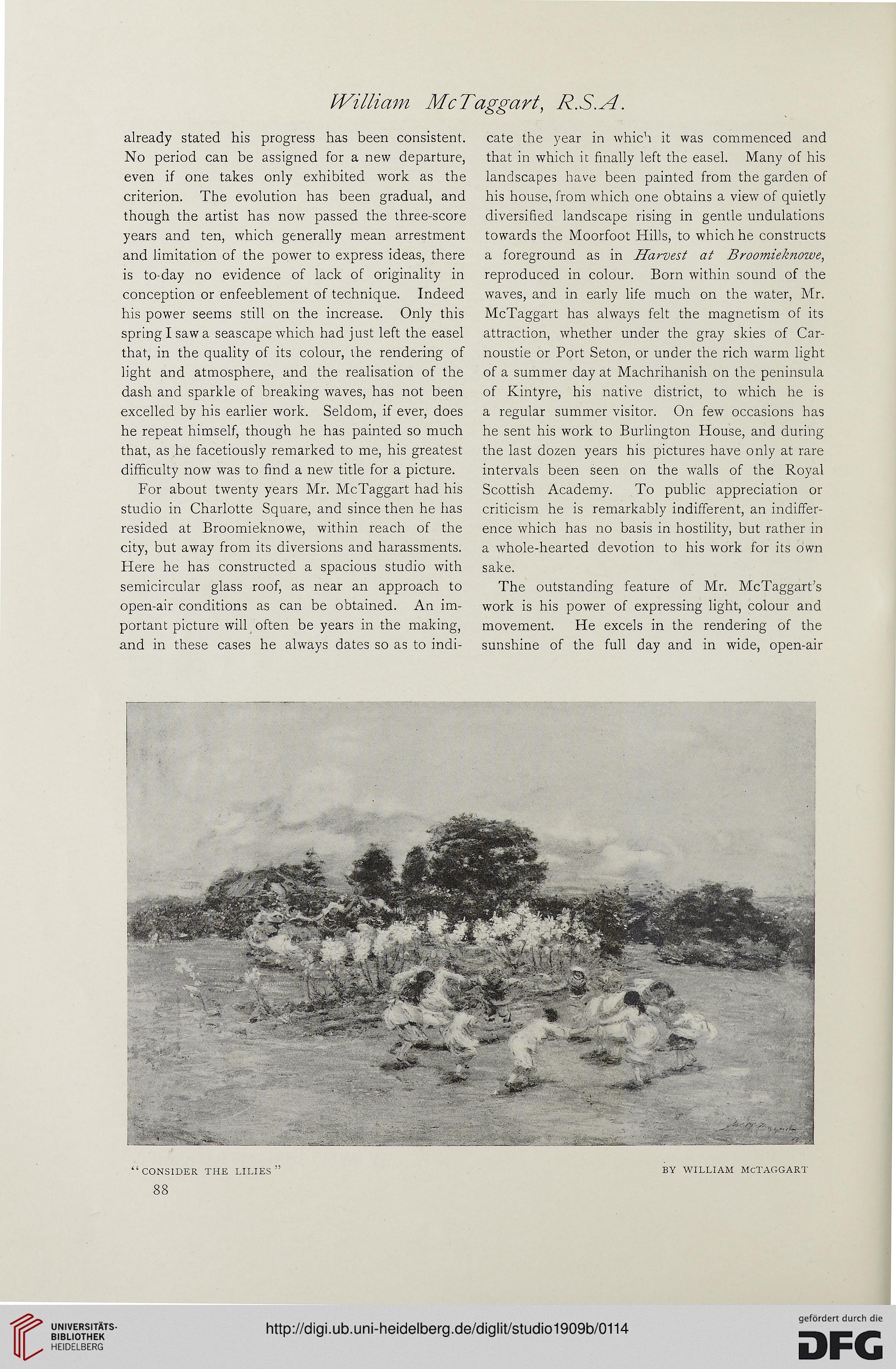IVilliam Me Taggart, R.S.A.
already stated his progress has been consistent.
No period can be assigned for a new departure,
even if one takes only exhibited work as the
criterion. The evolution has been gradual, and
though the artist has now passed the three-score
years and ten, which generally mean arrestment
and limitation of the power to express ideas, there
is to-day no evidence of lack of originality in
conception or enfeeblement of technique. Indeed
his power seems still on the increase. Only this
spring I saw a seascape which had just left the easel
that, in the quality of its colour, the rendering of
light and atmosphere, and the realisation of the
dash and sparkle of breaking waves, has not been
excelled by his earlier work. Seldom, if ever, does
he repeat himself, though he has painted so much
that, as he facetiously remarked to me, his greatest
difficulty now was to find a new title for a picture.
For about twenty years Mr. McTaggart had his
studio in Charlotte Square, and since then he has
resided at Broomieknowe, within reach of the
city, but away from its diversions and harassments.
Here he has constructed a spacious studio with
semicircular glass roof, as near an approach to
open-air conditions as can be obtained. An im-
portant picture will often be years in the making,
and in these cases he always dates so as to indi-
cate the year in which it was commenced and
that in which it finally left the easel. Many of his
landscapes have been painted from the garden of
his house, from which one obtains a view of quietly
diversified landscape rising in gentle undulations
towards the Moorfoot Hills, to which he constructs
a foreground as in Harvest at Broomieknowe,
reproduced in colour. Born within sound of the
waves, and in early life much on the water, Mr.
McTaggart has always felt the magnetism of its
attraction, whether under the gray skies of Car-
noustie or Port Seton, or under the rich warm light
of a summer day at Machrihanish on the peninsula
of Kintyre, his native district, to which he is
a regular summer visitor. On few occasions has
he sent his work to Burlington House, and during
the last dozen years his pictures have only at rare
intervals been seen on the walls of the Royal
Scottish Academy. To public appreciation or
criticism he is remarkably indifferent, an indiffer-
ence which has no basis in hostility, but rather in
a whole-hearted devotion to his work for its own
sake.
The outstanding feature of Mr. McTaggart’s
work is his power of expressing light, colour and
movement. He excels in the rendering of the
sunshine of the full day and in wide, open-air
“CONSIDER THE LILIES” by WILLIAM MCTAGGART
already stated his progress has been consistent.
No period can be assigned for a new departure,
even if one takes only exhibited work as the
criterion. The evolution has been gradual, and
though the artist has now passed the three-score
years and ten, which generally mean arrestment
and limitation of the power to express ideas, there
is to-day no evidence of lack of originality in
conception or enfeeblement of technique. Indeed
his power seems still on the increase. Only this
spring I saw a seascape which had just left the easel
that, in the quality of its colour, the rendering of
light and atmosphere, and the realisation of the
dash and sparkle of breaking waves, has not been
excelled by his earlier work. Seldom, if ever, does
he repeat himself, though he has painted so much
that, as he facetiously remarked to me, his greatest
difficulty now was to find a new title for a picture.
For about twenty years Mr. McTaggart had his
studio in Charlotte Square, and since then he has
resided at Broomieknowe, within reach of the
city, but away from its diversions and harassments.
Here he has constructed a spacious studio with
semicircular glass roof, as near an approach to
open-air conditions as can be obtained. An im-
portant picture will often be years in the making,
and in these cases he always dates so as to indi-
cate the year in which it was commenced and
that in which it finally left the easel. Many of his
landscapes have been painted from the garden of
his house, from which one obtains a view of quietly
diversified landscape rising in gentle undulations
towards the Moorfoot Hills, to which he constructs
a foreground as in Harvest at Broomieknowe,
reproduced in colour. Born within sound of the
waves, and in early life much on the water, Mr.
McTaggart has always felt the magnetism of its
attraction, whether under the gray skies of Car-
noustie or Port Seton, or under the rich warm light
of a summer day at Machrihanish on the peninsula
of Kintyre, his native district, to which he is
a regular summer visitor. On few occasions has
he sent his work to Burlington House, and during
the last dozen years his pictures have only at rare
intervals been seen on the walls of the Royal
Scottish Academy. To public appreciation or
criticism he is remarkably indifferent, an indiffer-
ence which has no basis in hostility, but rather in
a whole-hearted devotion to his work for its own
sake.
The outstanding feature of Mr. McTaggart’s
work is his power of expressing light, colour and
movement. He excels in the rendering of the
sunshine of the full day and in wide, open-air
“CONSIDER THE LILIES” by WILLIAM MCTAGGART




